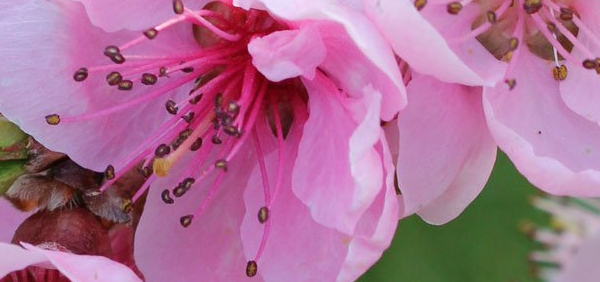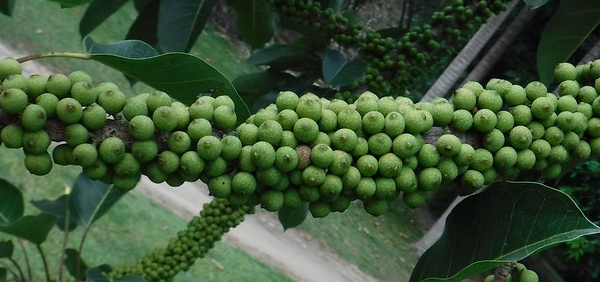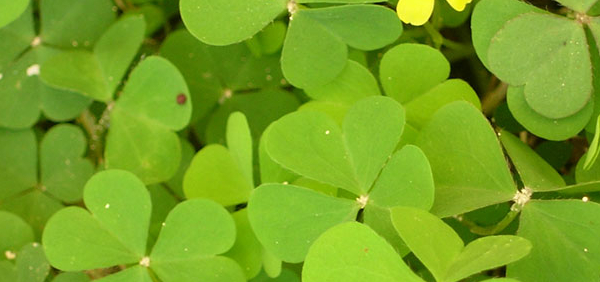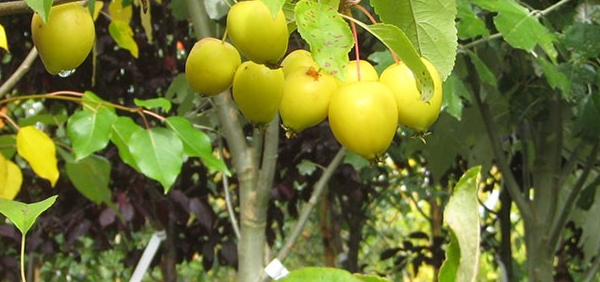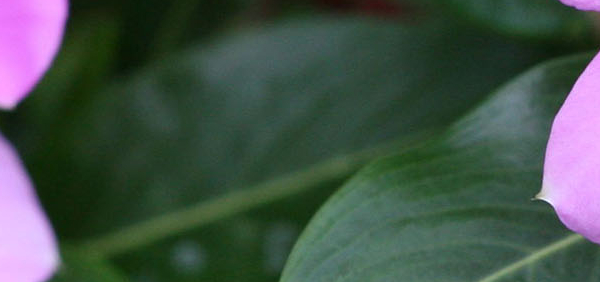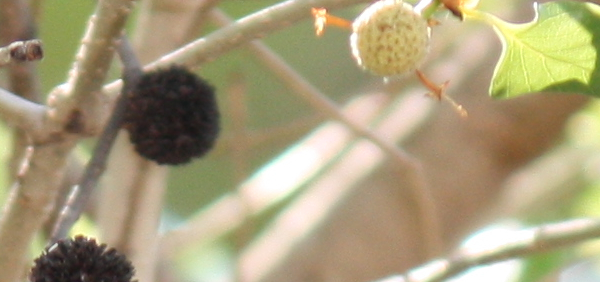krishnacandana :

Morphology:
A large woody climber, grows with cylindrical and yellowish stem. Leaves simple, oblong, deltoid, minutely tomentose beneath, smooth above, with yellowish tint. Flowers yellow, unisexual, in supra-axillary inflorescence. Fruits globose drupes, 1-seeded. Seeds globose.Coscinium fenestratum is a sturdy woody climber with leathery, shiny leaves and a brightly yellow sap. It is dioecious, flowering and fruiting in August to October. The fruits consists of one or two drupes up to 2 cm (0.8 in) across. The plant has a generation span of 25 years.
A large dioecious liana up to 10 m long, with yellow wood and sap. The stem and root slices are hard and woody. Wood is yellowish-brown in colour externally and yellow internally. The drug occurs in large woody, cylindrical, straight pieces, sometimes as much as 10 cm in diameter (Anonymous, 2001; http://www.ibiblio.org). Branchlets terete, brown tomentose, later glabrescent with disciform petiole-scars. Leaves simple, alternate, exstipulate, broadly ovate, rounded, truncate or shallowly cordate at base, acuminate at apex, 10-32x8-22 cm, glabrescent above, hoary yellowish-white tomentellous beneath, thinly coriaceous; main nerves 5-7, palmate, with 2 pairs of distal lateral nerves; midrib and other main nerves sunken, whitish tomentose beneath; petioles 3-16 cm long, conspicuously swollen at both ends, geniculate at base, inserted up to 0.8 cm above basal margin on the lamina of leaf; stipules absent. Inflorescence globose heads on 1-3 cm long peduncles, of 5-11 cm long racemes, 6-7 mm across, supra-axillary or on old leafless stems; bracts subulate, villous, closely pressed on the calyx, those of peduncles small, 4-5 mm long. Flowers unisexual, small, yellowish or whitish; sepals 9, in 3 whorls, imbricate, densely sericeous-pilose; petals absent; Male flowers: sessile or shortly pedicellate, ca. 1 mm long; sepals broadly elliptic to obovate, 1.5-2 mm long, densely sericeous outside, glabrous inside, yellow; outer ones 3-6, broadly elliptic, 1-1.5 mm long; inner ones 3-6, spreading, 1.5-2 mm long, yellow. Stamens 6, outer 3 free and inner connate to the middle; filaments ca. 1 mm long; anthers small, oval, adnate, outer ones one-celled, inner ones two-celled; pollen grains oblate-spheroidal or rarely spheroidal, triporate having reticulate tectum and lumina with fine granules (Ferguson, 1978). Female flowers: 3-6 free, subglobose carpels with slender subulate recurved or filiform styles, staminodes 6. Drupes 1-3, on globose, 7-8 mm in diam. gynophore, subglobose, 2.6-3 cm across, brown, orange or yellow, tomentellous; pericarp woody when dry, ca. 1 mm thick; endocarp bony, 2.2-2.5 cm in diam., with persistent calyx. Seeds whitish, subglobose with divaricate, much folded and divided cotyledons; hollow within, peltate, enclosing condyle; endosperm present. Embryo having very thin divaricate cotyledons with an irregular margin and a small superior radicle. Flowering season is from November-December (Sharma et al., 1993; Kolammal, 1978). Rema Shree et al. (2006) has conducted detailed micromorphological studies on the leaf and revealed that the dense tomentum composed of two types of trichomes in the abaxial surface of C. fenestratum is a striking feature that distinguishes this species from other genera of the tribe Coscinieae. The study conducted at the authors lab confirmed the chromosome number as 2n = 16.
Population studies of C. fenestratum revealed that they survive and regenerate naturally in disturbed habitats compared to undisturbed forest (Kathriarachchi et al., 2004). Assessment of genetic diversity in Coscinium fenestratum using RAPD markers revealed that there was less genetic diversity between the populations (Narasimhan et al., 2006). FRLHT, Bangalore, in collaboration with the Forest department has established a Medicinal Plant Conservation Area (MPCA) at Kulamavu in Idukki district of Kerala exclusively for the conservation of this endangered species.
Anatomy
Transverse section of young stem reveals single layered epidermis with certain ridges at regular intervals and is fully covered with very long uniseriate, multicellular tuft of hairs. Cortex consists of rectangular and polyhedral, thin walled, 4-6 layered collenchymatous cells consisting of very prominent yellowish bands of hard stone cells with crystals inside. Thirty to thirty five vascular bundles are arranged in a broken ring. Just above each vascular bundle, arches of 15-18 layered sclerenchymatous cells with lysigenous cavities are present opposite to the phloem in definite patches. In between the arches, 2-4 layers of chlorenchymatous tissue are present. The 1-2 layered interfascicular cambium originates in between the bundles, in line with the fascicular cambium, resulting in a ring of 2-6 layered cambium. The primary phloem cells are found below these arches. Secondary phloem, consisting of large sieve tubes and companion cells is present above the secondary xylem forming a cup like structure. Primary xylem consists of vessel elements with pitted thickening, annular and spiral tracheids and fibres. Outermost zone is cork, composed of 20-30 rows of moderately thick-walled cells with inclusions. Anomalous secondary thickening with fissured xylem and continuous vascular cambium is observed in the mature stem. Wood region consists of xylem strips, composed of large sized vessels, fibres, axial parenchyma and tracheids that are alternate to the thick walled medullary rays. Broad medullary rays, consisting of 30-40 layers and lying alternate to the conductive tissues, occupy almost half of the xylem region. Pith is very prominent and parenchymatous consisting of thick walled and closely packed cells towards the periphery and large, circular to polyhedral and comparatively thin walled cells with inter cellular spaces towards the centre. Starch grains are smaller and present throughout the pith and medullary rays. A group of yellow coloured stone cells are also present in the center of the pith (Nambiar et al., 2000; Rema Shree et al., 2005). The stem of Coscinium can be easily distinguished from that of Berberis by large vessels in the wood, bright greenish yellow colour with open, porous structures and devoid of crenate rings. Wood is lighter and softer than Berberis sp. (Anonymous, 2001).
Outermost region of the root consists of 10-13 rows of thick walled cells. The cortex is rectangular and thin walled with oil drops in certain cells. Inner boundary of the cortex forms a wavy band of several arches composed of yellow coloured thick walled cells composed of longer, elongated stone cells that form major portion of the band in addition to a few short sclerenchymatous cells. Below these arches some crushed secondary and primary phloem are seen. Wood consists of large sized vessels, xylem parenchyma and thick walled fibres. Medullary rays consist of multiseriate radially elongated thick walled cells, seen in between the secondary xylem region. Pith is not discriminable in old roots (Nambiar et al., 2000).
Transverse section of petiole shows single layered epidermis with thin cuticle and multicellular and uniseriate trichomes. Cortical region is parenchymatous with vascular bundles in a ring and a sclerenchymatous bundle cap above each bundle. In the centre of the petiole, parenchymatous cells are large and loosely arranged (Nambiar et al., 2000).
Transverse section of the leaf midrib shows thick and thin-walled rosette cells. Epidermis is single layered with lower region possessing large number of multicellular and uniseriate trichomes. The epidermal cells are tangentially elongated with straight anticlinal and smooth periclinal walls with cuticle. The mesophyll consists of 1-2 layered, thick walled, highly chlorophyllous palisade tissue and 2-4 layered, thin walled and spongy tissue with abundant intercellular spaces. Vascular bundle is encircled by a wavy ring of 2-10 layers of sclerenchymatous tissue. Collenchyma and parenchyma cells are present wherein the latter is mostly filled with yellow coloured berberine deposits. Stomata are Ranunculaceous type. Stomatal index is 29.31, palisade ratio is 3.81 and vein-islet number is 29.31 (Nambiar et al., 2000; Remashree et al., 2006). The leaf anatomy of the tribe Coscinieae has been described by Wilkinson (1978).
Powder colour of stem and root is yellow and of leaf is dark brown. It has a bitter taste without any characteristic odour (Pinho et al., 1992; Nambiar et al., 2000; Anonymous, 2005).
Quantitative Standards Root
Foreign matter: Not more than 1%, Ash: Not more than 2%, Acid insoluble ash: Not more than 0.4%, Ethanol soluble extractive: Not less than 11%, Water soluble extractive: Not less than 10% .
Stem
Foreign matter: Not more than 1%, Ash: Not more than 3%, Acid insoluble ash: Not more than 2%, Ethanol soluble extractive: Not less than 3%, Water soluble extractive: Not less than 8% (Anonymous, 2005).
- » Classification and names of krishnacandana
- » Synonyms and definitions of krishnacandana
- » Drug Properties of krishnacandana
- » Chemical Constituents of krishnacandana
- » Standardization of krishnacandana
- » Parts used and Dosage of krishnacandana
- » Morphology and Histology of krishnacandana
- » Distribution and Conservation of krishnacandana
- » Cultivation of krishnacandana
- » krishnacandana in the market
- » Medicinal Uses of krishnacandana
- » Researches and clinical trails of krishnacandana
- » krishnacandana in other sytems of medicine
- » Ayurvedic formulations with krishnacandana
- » Images of krishnacandana



